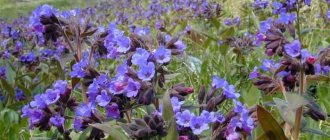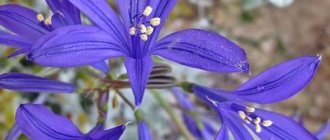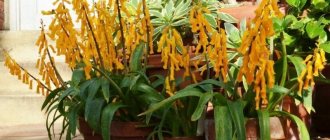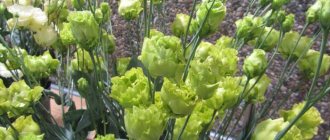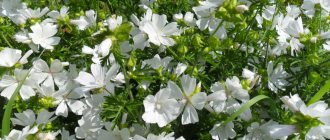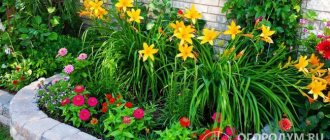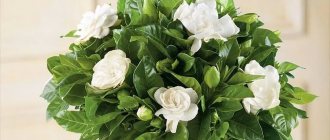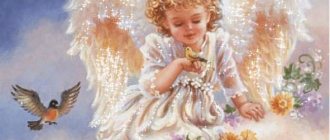Meadow and wildflowers are so beautiful and fragrant that many people like to make natural bouquets from them.
And meadow flowers are also used for meadow and heather lawns and simply in the garden.
Many of them are popular medicinal plants that are sold in pharmacies.
However, many people do not even know the names of these flowers, where they grow, their properties and uses. In this article we have collected the most popular and beautiful wild and meadow flowers with photographs, plant names and descriptions.
Variety of wild and meadow flowers
If you happen to admire a flowering field, then this magical sight will be remembered forever.
The sea, swaying from the slightest breeze, emitting a stupefying aroma, instills peace and tranquility even in pragmatic people. Wildflowers come in a very wide variety of unique colors. By the way, cornflower has a shade that is not found anywhere else in nature.
To date, scientists have described slightly less than 300 thousand species of wildflowers out of the existing 500,000. By the way, many of them are famous for their healing properties and therefore have been used in folk medicine since ancient times. The most useful are the following:
- cornflower;
- chamomile;
- dog violet;
- bell.
In recent years, in many regions of the country, summer residents are increasingly growing wildflowers on their plots. Most of their varieties are used as a background when decorating flower beds or creating borders.
These include, in particular:
- poppies;
- chamomile;
- bells.
Experts were also able to cultivate cornflower. Moreover, in addition to the unique shade, varieties with a different color also appeared:
- white;
- pink;
- purple, etc.
Below we will describe the most attractive representatives of wild flowers that decorate Russian spaces everywhere. © 2022, Copyright reserved! A link when copying is required! | Source: flowers-republic.ru
Yellow grasses of natural landscapes
Buttercup
Many people call this flower the “rose of the fields.” Indeed, a certain similarity is noticeable to the naked eye. However, unlike the “queen of the garden,” the buttercup does not have thorns.
The flower is particularly charming, largely due to its great toxicity. Its juice is a powerful poison that the indigenous peoples of Siberia have used since ancient times to lubricate arrows.
Many people do not believe that irises are wildflowers. Nevertheless, it is so. This plant is different:
- gracefulness;
- elegance;
- non-capriciousness.
The plant goes well with many other wildflowers and lasts a long time in a vase. It is known that a bouquet of irises is the best gift for an extraordinary person. © 2022, Copyright reserved! A link when copying is required! | Source: flowers-republic.ru
This is a poisonous flower, but when consumed in small quantities it has medicinal effects:
- relieves pain in joints;
- helps open boils and carbuncles;
- relieves stomach cramps;
- eliminates migraine;
- stimulates the central nervous system;
- increases hemoglobin;
- treats skin tuberculosis;
- kills bacteria and fungi.
St. John's wort
St. John's wort blooms from June to August. The leafy tops of the medicinal plant, together with the inflorescences, are used to relieve pain and as an antiseptic and diuretic. Most often, the flower can be found in open glades, forest edges, and meadows.
Effective for treating:
- colds and coughs;
- urolithiasis and cystitis;
- CVS pathologies;
- inflammation in the oral cavity;
- nerves, depression, stress;
- hematomas and bruises;
- burns.
Goose onion
Yellowflower appears immediately after the snow melts. The plant reaches a height of 15 cm, the flower has 6 yellowish-greenish petals. The fruit of the goose onion is formed at the end of May in the form of a small round box.
Recommended for spring vitamin deficiencies. Helps with epilepsy, bronchial asthma, hepatitis. Has wound-healing and antiseptic effects.
Dandelion
Yellow buds can be found in almost every corner of Russia. Dandelion is considered the most common meadow flower in the world. It cannot boast of any richness of aroma or special grace. However, the culture is considered edible, which is why many cuisines include dandelion dishes. © 2022, Copyright reserved! A link when copying is required! | Source: flowers-republic.ru
Dandelion:
- eliminates pain and swelling from a bee sting;
- helps with colds;
- heals skin damage;
- relieves anemia;
- softens the symptoms of tuberculosis;
- eliminates cholesterol plaques;
- treats eczema;
- improves the functioning of the digestive organs, promotes the production of gastric juice, improves appetite;
- removes acne and papillomas;
- whitens the skin, hides pigmentation and freckles.
Sweet clover
Sweet clover is also a yellow wildflower. This is one of the tallest flowers, growing above human height (up to 2 m). The stems are evenly covered with three-fingered leaves. Small flowers (yellow or white) are arranged in racemes.
Sweet clover heals wounds, relieves inflammation and cramps, and treats wet cough.
What are meadow plants?
Meadow plants are a fairly rich community, developing more dynamically than mountain or steppe plants. Meadow flowers and grasses compete for light, nutrients, and water, and therefore grow much more actively than their forest counterparts, as well as representatives of the mountains and steppes.
Interesting materials:
How to check the authenticity of a 2000 bill? How to check a charter flight reservation? How to check a receipt without a QR code? How to check the validity of a pass? How to check whether a company is active or not? How to check the authenticity of a diploma in Ukraine? How to check an electronic pass in Moscow? How to check if there is deportation to Russia? How to check a company's reliability using its TIN? How to check battery wear on iOS 12?
Purple and blue wildflowers
Field violet
The field beauty blooms from May to August. The violet reproduces by self-sowing and bears fruit in a small box of seeds.
This extremely delicate flower is in first place in popularity among lovers around the world. There is hardly a single garden where there are no violets at all.
Today, approximately 500 varieties of the named wildflower are known to man. Each one is different:
- unique appearance;
- aroma;
- shade.
Flowers, among other things, are both smooth and velvety. © 2022, Copyright reserved! A link when copying is required! | Source: flowers-republic.ru
Delphinium
The beauty of this flower has long made it a welcome guest in summer cottages. By the way, there is a rather romantic story associated with delphinium that explains its origin. Let us present it briefly.
Once upon a time in Greece there lived a certain young man, very talented and hopelessly in love with a dead girl. Trying to bring her back from the other world, he carved a statue out of marble and managed to revive it. However, this act was negatively assessed by the gods. The young man was turned into a dolphin.
The beauty spent a lot of time on the coast, hoping to see her beloved at least once. Only once did a dolphin swim up to her and give her a flowering plant.
Today, there are more than 400 varieties of the mentioned flower, making it one of the most common wild plants. © 2022, Copyright reserved! A link when copying is required! | Source: flowers-republic.ru
Soap is made from the flower. Also helps with:
- migraines;
- toothache;
- cystitis;
- conjunctivitis;
- pneumonia;
- pleurisy;
- skin infections;
- bone fractures.
Used to block nerve endings and relax smooth muscles.
Common bluebell
This flower is rightfully considered one of the most beautiful in the world. There are many varieties of it, differing not only in shape, but also in color.
It is especially worth noting its divine subtle aroma. © 2022, Copyright reserved! A link when copying is required! | Source: flowers-republic.ru
Mainly used for decoration. However, the flower also has medicinal properties:
- anti-inflammatory;
- antimicrobial;
- calming;
- painkillers.
The bell can be used to treat: fever, cough, migraine, uterine hemorrhage, severe pain during menstruation, sore throat, wounds from animal bites, skin lesions, stomatitis, lichen, epilepsy.
“A ringing bell is ringing in the field, this delicate flower on a stem is laughing”!
The field bell is another representative of the most beautiful flowers in the world and the entire planet. It comes in different colors and shapes, but they all resemble small bells. And you can’t even imagine what a divine aroma this musical wildflower has.
Iris
The handsome iris, a proud and exquisite flower, can truly lay claim to the title of king of wildflowers. It blends in very naturally with the living wild nature. Its unusual shape and color scheme fascinates and attracts.
Used to create confectionery products. Flowers decorate summer cottages, squares, parks, etc. Treats: cough, constipation, neuroses, stress, migraines, dense tumors, colic, sore throat, pneumonia.
In cosmetology it is used to remove freckles and acne. Prevents the appearance of wrinkles and dandruff.
These flowers are suitable for extraordinary personalities and will decorate any bouquet, especially a bouquet of wildflowers.
Chicory
It has a powerful, fleshy root filled with milky juice. The stem with multiple branches grows up to 120 cm in height. The leaves grow from the middle part of the stems and are collected in rosettes. The flowers of this meadow plant are blue-blue (there are white and pink varieties), with jagged petals, bordered by leaves, located along the length of the stems and at their tops. Loves the sun, flowers close in the afternoon.
Chicory is good for the nervous system, heart and blood vessels, kidneys and liver. It is a healing food for animals.
Oregano
Oregano blooms in July-September. The plant reaches a height of 70-90 cm, has delicate pinkish-purple inflorescences. Oregano grows in coniferous forests, meadows, forest edges, and open clearings.
Used as an antibacterial agent to disinfect hospitals and maternity hospitals from Staphylococcus aureus.
Helps with:
- central nervous system disorders: insomnia, depression, depression, loss of strength, neuroses, convulsive seizures (including epileptic);
- gastrointestinal diseases: reduces gas formation, improves the production of gastric juice during gastritis with low acidity, normalizes the output of bile, relieves spasms, helps digestion;
- urolithiasis: has diuretic properties;
- severe pain syndrome and hyperthermia;
- gynecological diseases: bleeding, hormonal imbalances, menopause.
Found application in cooking. Gives dishes a spicy, refined taste.
Crocus (saffron)
One of the most beautiful primroses blooms in the first months of spring. Some species bloom in mid-autumn. Plants are planted in loose, fertilized soil with drainage.
Cornflowers
We have already said a lot about the named wildflower at the beginning of the article. What makes it different:
- tenderness;
- fragility;
- heavenly blue petals;
- the subtlest intoxicating smell.
Cornflowers grow mainly in meadows and forest clearings. The plant really likes rye fields. During flowering, bees from all over the area flock to it - connoisseurs assure that cornflower honey is one of the most delicious and healthy.
Cornflower helps with:
- damage to the kidneys and urinary tract;
- cardiovascular diseases;
- eye problems;
- women's diseases;
- pain in the joints and gastrointestinal tract.
The petals are also used to make tea. © 2022, Copyright reserved! A link when copying is required! | Source: flowers-republic.ru
Pansies
This plant is also called tricolor violet, St. John's wort, Maryansky royal tree.
Interesting! Popularly accepted names: hatchets, trichomes, brother and sister, field pansies, moths, half-flowers.
A perennial, hardy herbaceous plant up to 40 cm high with alternate, petiolate leaves that become small at the top of the stem. Flowers on thin stalks are tricolored, tetrahedral, reaching 6 cm in diameter. It grows everywhere. Used in medicine for respiratory diseases.
Ledum (Klopovnik)
A perennial shrub up to 2 m high with small blue-green leaves along the stem. The flowers are crimson, four-lobed, fragrant, reaching 4 cm in diameter. They are numerous in umbrellas. It grows everywhere. Used in cosmetology and medicine for whooping cough and rheumatism.
Valerian medicinal
Important: This plant is also called cat root, cat grass, mauna grass, oregano, odolyan, earthen frankincense, fenugreek, marshmallow, pink yarrow.
A perennial herbaceous flower growing up to 150 cm in height, with long-tailed leaves that do not densely cover the stem. The flowers are small, pale pink, fragrant, reaching 5 mm in diameter. They are collected in umbrella-shaped inflorescences. It grows everywhere.
Used in medicine as a sedative and antispasmodic. Valerian is also used in cosmetology.
Cornflower blue
Interesting! Common names: Oxysize, blue, Blavatsky.
Perennial meadow flower, grows up to 1 m tall. The leaves are lanceolate, ovate, blue-green. The flowers are blue in various shades and reach a diameter of up to 5 cm. They are collected in basket-like inflorescences. It grows everywhere.
Important: In medicine it is used for conjunctivitis, inflammation of the eyelids, eye fatigue and as an anti-inflammatory and disinfectant. Cornflowers are also used in cosmetics.
Dianthus meadow
A perennial herbaceous dicotyledonous flower growing to a height of about 40 cm with hairy, linear leaves. The flowers, which have five serrated petals, can be red, pink or, less commonly, white. This meadow plant is protected in the Saratov region.
Important: Used in medicine to treat infertility.
Meadow geranium
A perennial herbaceous dicotyledonous flower up to 80 cm high with five separate stem leaves below and three separate leaves above. The flowers are large, wide with five petals of lilac color. There are a lot of them. It grows everywhere.
Important: In medicine it is used to prepare infusions and decoctions for insomnia.
Elecampane
A perennial herbaceous dicotyledonous plant up to 100 cm high, with narrow, massive, light green leaves. The flowers are orange or yellow, arranged singly or in disc-shaped clusters. It grows everywhere.
Important: In medicine it is used as an expectorant for chronic bronchitis, tracheitis, and pulmonary tuberculosis. It is also often used in cosmetology.
Delphinium (larkspur, spur)
A perennial shrub up to 150 cm high with arrow-shaped leaves growing from the root zone. Flowers are small, pyramidal inflorescences located on a long stem. They can be of different shades: white, blue, pink, lilac, red, yellow. It grows in regions with warm climates.
Important: Do not use the plant in its pure form, as it is poisonous.
Used in soap production. Used medicinally to treat respiratory conditions such as asthma, severe cough and pneumonia, as a pain reliever.
St. John's wort (common)
A perennial herbaceous flower that grows to a height of 80 cm. Elliptical, dark green leaves arranged symmetrically on an erect stem. The flowers are bright yellow, in corimba-like inflorescences, growing in Russia and Ukraine.
Important: In medicine it is used as a medicinal plant to treat infected wounds, ulcers and burns. In dentistry, St. John's wort tincture is used as a mouth rinse for gingivitis and stomatitis.
Iris (Iris, Cockerel)
A rhizomatous perennial up to 60 cm high with flat, paniculate leaves collected at the base of the stem, which can be single or collected in bunches. The flowers are yellow, violet, white, purple, burgundy, pink, and can be single or collected in clusters of 3. It grows everywhere.
Important: Used in cosmetology to remove freckles, pimples, wrinkles and stimulate hair growth.
Fireweed angustifolia (Ivan-tea)
Interesting! Also known as plane tree, matrona, breadfruit, miller, Koporsky tea, crinella, Russian tea, koporka, wild flax.
Perennial herbaceous flower, grows up to 50-150 cm in height. The leaves are linear-lanceolate, pointed, dark green, densely located on an erect, rounded stem. The flowers are pink, four-petaled with a double perianth, ovoid, reaching a diameter of 3 cm. They are located in an apical rachis 45 cm long. It grows everywhere.
Used in medicine and cosmetology as an anti-inflammatory, soothing and inflammatory agent. Also for the treatment of psoriasis, lichen ruber, neurodermatitis, eczema.
Interesting! It is collected in the summer, dried, fermented and a very healthy and tasty tea drink called Koporye tea is obtained.
Clover pink
A perennial herbaceous flowering plant up to 80 cm high, with oval, triangular leaves and a tubular, branched, erect stem. The flowers are pink or raspberry-coral, collected in spherical inflorescences with heads. It grows everywhere. An excellent honey and fodder plant.
Important: Used for boils, burns and rheumatic pain.
Common bluebell
A rare biennial herbaceous flower that grows up to 70 cm in height and reproduces by self-sowing. The leaves are small, arranged in rows on a vertical, slender stem. The corolla is bell-shaped. The flowers are purple, collected in panicles or panicle-like inflorescences. Grows in temperate climates.
Important: The plant is used as an anti-inflammatory, adhesive, analgesic and soothing agent for skin diseases.
Lily of the valley
A perennial herbaceous flower of the lily of the valley family, growing up to 40 cm in height with large, oval, light green leaves arranged symmetrically in pairs at the base. The stem is slender, bare, erect. The flowers are small, white, fragrant, collected in a spike-shaped inflorescence. It grows everywhere.
Important! In folk and classical medicine, lily of the valley is used to prepare tinctures for neuroses. It is also used in cosmetics and soap making.
Common flax
An annual herbaceous flower, up to 80 cm high, propagated by self-sowing. Narrow, small leaves, symmetrically arranged on an erect, branched stem. The flowers are blue, five-petaled, solitary on long stalks. It grows everywhere.
Important: Linen is used in cooking, cosmetics and textiles. In medicine, the plant is used as a mild laxative for spastic constipation, and also externally for burns.
Common toadflax
A perennial herbaceous plant of the paniculaceae family, growing up to 90 cm in height, with small, linear, pointed leaves, densely arranged on an erect stem. The flowers are small, yellow with an orange center, collected at the top in clusters up to 15 cm. It grows everywhere.
Important: The plant is used in floriculture. In medicine, it is used for skin diseases, in the treatment of urolithiasis and gallstones.
Lupine
A perennial subshrub up to 80-120 cm high with compound leaves consisting of long, narrow lobes. Stems are woody, erect, with variegated foliage. The flowers are zygomorphic, dark blue or purple, collected in apical inflorescences in the form of a cluster. Grows in temperate climates.
Important: In medicine it is used for type 2 diabetes, pain and spasms. It is also used in cosmetics, floristry, pharmacology and the food industry.
Creeping buttercup
A perennial herbaceous plant up to 15-40 cm high with trifoliate, petiolate, basal leaves. The stem is thick and creeping. The flowers are fragrant, five-lobed, golden yellow, arranged solitary. It grows everywhere.
Important: Used in folk and classical medicine to remove warts, scabies and purulent wounds in animals.
Field poppy (self-seeded)
An annual herbaceous flower, grows to a height of 30-80 cm, propagated by self-sowing. The leaves are large, alternate, pinnate, with a gray-green tint. The stem is branched with dense bristles. The flowers are large in diameter, up to 7 cm red or scarlet, consist of petals in 2 tiers and black stamens. They are located singly on long, strong stems. It grows everywhere.
Important: Used in alternative medicine as a cough syrup and sedative.
Coltsfoot
A perennial herbaceous flower of the Asteraceae family, growing up to 30 cm in height, with basal, oval or heart-shaped leaves separated by veins. The stem is erect. The flowers are yellow, dandelion-like, solitary. Grows in temperate climates. Excellent honey bee.
Important: In medicine, the plant is used externally to treat skin infections and wounds. It is considered an excellent expectorant.
Lungwort
A perennial herbaceous flower growing up to 30 cm in height with lanceolate, oval leaves. The radial leaves are larger than the stem leaves, the stem is erect and covered with hairs. The flowers are blue or blue bell-shaped with a double perianth. It grows everywhere.
Important: The plant is used in cooking, as well as in traditional and classical medicine. Seaweed tea is prescribed for sore throat, cough, dysentery and diarrhea, as well as bladder problems.
Dandelion
A perennial herbaceous flower of the Asteraceae family, up to 60 cm high with feathery, spiny leaves. The stem is multi-petalled, erect. The flowers are yellow, solitary. Rich, white sap is present in all parts of the plant. It grows everywhere.
Important: Used in the food industry, medicine, cosmetology and animal feed. Dandelion infusion and decoction are used for pancreatitis, gastritis, cholecystitis, constipation and diabetes.
Interesting! Royal jelly and dandelion are similar in flower shade and belong to the Asteraceae family. However, these are different types. They vary in leaf shape. Dandelion leaves are oblong, and comfrey leaves are wide.
Medicinal comfrey or larkspur
A perennial herbaceous flower growing up to 100 cm in height, with feathery green oblong leaves. The stem is erect, branched, and covered with stiff hairs. The flowers are bell-shaped and purple at the top of the stem. It grows everywhere. Excellent honey bee.
Important: In medicine, milk thistle is used to treat wounds, ulcers, bone ailments, rheumatoid fever, gout, osteochondrosis, arthritis, arthrosis, periostitis, dislocations and bone fractures.
Shepherd's Purse
A perennial herbaceous flower of the cabbage family, growing up to 60 cm in height, with small, alternate, heart-shaped leaves. The stem is straight, folded. The flowers are small, white, collected at the top of the stem. It grows everywhere.
Important: In gynecology, use the plant to treat uterine atony and uterine bleeding. The aerial part of the flower is used in veterinary medicine for diarrhea and internal bleeding.
Medicinal primrose or spring primrose
A perennial herbaceous flower growing to a height of about 80 cm, with light green, pinnate leaves clustered at the root zone. The stem is straight, bare. Yellow, five-lobed flowers collected in umbellate inflorescences. It grows everywhere.
Important: In medicine it is used to treat bronchitis, pharyngitis, osteochondrosis, and intervertebral hernia. It is also used as an ornamental plant and in the food industry.
Tansy
A perennial herbaceous flowering plant growing up to 50-150 cm in height, with palmate-serrate leaves. The stems are straight, branched at the top. The flowers are yellow, small, tubular, collected in umbrella-shaped inflorescences. It has a sharp camphor aroma. It grows everywhere.
Important: Pansies are used in food, classical and alternative medicine. It helps fight worms and is also used as a choleretic agent for liver diseases.
Ivy
A perennial shrub with dark green, angular, lobed leaves and a slender, climbing stem. The flowers are small, white, collected in inflorescences from above. Grows in temperate climates.
Important: In folk and classical medicine, ivy is used as an expectorant for diseases of the respiratory system, as well as for diseases of the digestive tract, gout, rickets, and tuberculosis.
Wormwood
A perennial herbaceous shrub up to 50-200 cm high with long pinnately divided leaves and an erect, branched stem. All wormwood is silvery-green. The flowers are yellow, small, like spherical baskets, located symmetrically along the entire length of the stem. It has a sharp camphor aroma. It grows throughout the area.
Important! Used in cooking to repel insects. It is used in medicine as an anthelmintic, anti-inflammatory, analgesic and wound healing agent. It is also used in the treatment of gastritis, peptic ulcers, and as a balm and poultice for bruises, purulent sores and ulcers, and for allergies.
Lumbago (Sleep-grass)
A perennial herbaceous flower up to 40 cm high with petiolate leaves in a rosette at the base. The stem is grayish, densely hairy. The flowers are large, purple with sharp petals. It grows everywhere.
Important: Classical medicine uses it as an expectorant. Also used in veterinary medicine. Poisonous.
Chamomile
A perennial herbaceous flower of the Asteraceae family, growing to a height of 30-80 cm, with small, narrow, sculptured leaves and an erect, branched stem. The flowers are white with a yellow center, collected in hemispherical baskets. It grows everywhere.
Chamomile is used in cosmetics, gardening and floriculture. Used to treat diseases of the digestive tract. Chamomile decoction is used to rinse the mouth for gingivitis, stomatitis, pharyngitis, and sore throat.
Meadowsweet or Meadowsweet
A perennial herbaceous flower of the Rosaceae family, up to 80 cm high, with ligulate leaves on long petioles, arranged in the shape of a star. The stem is simple, pinnate. The flowers are small, white or pink, collected in panicles. They have double inflorescences. Grows in temperate climates.
Important: The plant is used in traditional and classical medicine and the food industry. Used for liver detoxification, and also as an antibacterial, antiviral, sedative, anthelmintic, and antiulcer agent.
Yarrow or Cut Herb
A perennial herbaceous shrub of the Asteraceae or Asteraceae family with serrated, toothed or pinnately divided leaves. The stem is straight or slightly curved at the base. The flowers are white, collected in an inflorescence similar to a luminary, consisting of small baskets. It grows everywhere.
Important: medicinal plant, used in medicine as an astringent.
Field tulip
A perennial herbaceous bulbous flower of the lily family with smooth or wavy, oblong leaves growing from the base of the stem towards the center. The stem is straight, dense, with one stem. A young plant has 1 leaf, an adult has 2-4 leaves of blue-green color. The flowers are red, yellow, white or pink, solitary, six-petaled with many stamens.
Important: ornamental plant.
Horsetail
A perennial herbaceous flower of the horsetail genus, the horsetail family, growing up to 40-60 cm in height with brownish or pinkish generative stems, brownish triangular leaf spines and a pycnocarpous tip. The leaves are arranged in whorls of 6-12 pieces, which can be free or compound. It grows in subarctic, temperate and tropical climates.
Important: Horsetail is used in classical and alternative medicine, and the food industry. Used to treat edema, heart and lung failure.
Common chicory
A perennial herbaceous flower of the genus Chicory, family Asteraceae, growing up to 15-150 cm in height, with pinnate basal leaves, pubescent along the edges, tapering to a petiole at the base. A weed with an erect, staminate, green or bare green, rough stem. The baskets are single or collected in groups at the top of the stem. The flowers are blue or white, ligulate. Corolla 15-25 mm long. It grows everywhere.
Important: The plant is poisonous and is used for cooking. In medicine it is used to treat chronic cholecystitis, pneumonia, gastrointestinal diseases, poor digestion, liver cirrhosis, and jaundice.
Thyme, thyme
Important: This plant is also called: Bogorodskaya grass, thyme, thyme, heather, frogwort, boron pepper, chebarka, fly agaric, cistus.
A perennial herbaceous flower growing up to 40 cm in height, with thin stems and thin, small, green, oval leaves. The flowers are pinkish-purple, fragrant, collected in small, oblong inflorescences. Grows in Eastern Europe, Western Siberia, Eastern Russia and the Caucasus. This is an ornamental plant.
Important: Thyme is used in cosmetology. Also in medicine as a diuretic, anticonvulsant and sedative, for whooping cough, neuralgia, and stomach cramps.
Ramson, Bear onion
A perennial herbaceous flower growing up to 50 cm in height, with oblong, pointed leaves. The flowers are white in the shape of a hemispherical umbrella. Blooms in May/June. It is native to Central, Northern and Southern Europe, as well as Turkey.
Important: This is a cultivated edible plant.
Thistle
A spiny herbaceous flower growing up to 150 cm in height, with an erect stem and large, hard and spiny leaves. The flowers are pink or purple, like a basket. Blooms in July and August. Grows in Central Europe and Asia, North Africa and the USA.
Important: In classical and alternative medicine it is used to improve heart function, increase vascular tone, blood pressure and intestinal tone, and increase urine outflow. It is especially often used as an anticonvulsant.
Celandine
A perennial herbaceous shrub up to 50-100 cm high, with an erect, branched stem and lyre-shaped dark green leaves. The flowers are yellow and arranged in the shape of an umbrella. Blooms in May and August. It grows everywhere.
Important: Used in medicine as a local anti-inflammatory agent for skin diseases such as psoriasis, eczema, dermatitis.
Sage
Herbaceous perennial, subshrub 20-70 cm high with oblong gray-green leaves. The flowers are blue-violet, pink or white, collected in clusters. Blooms from May to July. It grows everywhere.
Important: Actively use sage in cosmetology. In medicine it is used to treat inflammatory diseases of the oropharynx and nasopharynx.
Rosehip cinnamon
A thorny perennial shrub up to 200 cm tall with unpaired leaves with 5-7 slots. The flowers are pink to dark red, arranged singly or in groups of 2-3 pieces. Blooms from May to July. Grows in Europe and Central Asia. A medicinal plant, used medicinally as an eye balm and gargle.
Stock rose
Also called mallow.
A perennial or biennial herbaceous flower growing up to 200 cm in height, with alternate leaves and a herbaceous stem, reproducing by self-seeding. The flowers are white, pink, yellowish, cream or pink with 5 intersecting petals. It grows everywhere.
Important: has decorative and medicinal properties. Used to enhance red color in winemaking and cooking. In medicine it is used to treat gastritis and colitis.
Echinacea
A perennial herbaceous flower growing up to 100 cm in height with a straight, coarse stem. The leaves are wide, tapering to a long petiole. The flowers are pink to reddish-brown, large and collected in baskets up to 15 cm in diameter. It is found in the eastern United States.
Important! It has both decorative and medicinal properties. Echinacea is used to boost immunity, treat wounds, smallpox, septicemia and giardiasis.
Eschszolzia
Perennial herbaceous sun-loving flower, grows to a height of 20-45 cm. Triangular leaves on long petioles. The flowers are cup-shaped, white to orange. Blooms from June to October. It is native to western North America. The plant is decorative.
Important: In medicine it is used as an antispasmodic and mild anesthetic.
Snooze
Perennial plant of the genus Umbellifera. The stem is straight, branched at the top, reaching up to 1 m in height. The leaves are longitudinally ovate, pointed, up to 8 cm long. It grows in mixed forests, shrubs and clearings and causes a lot of trouble for gardeners, as it multiplies quickly and fills everything around. Shade resistant. Suitable for eating, in salads, cabbage soup and borscht instead of cabbage.
Used in medicine as a remedy for burns.
Very difficult to get rid of. It is necessary to reduce the acidity of the soil. The process is long. Chalk, lime or dolomite will gradually reduce the number of shoots, and over time the weed will move to a place where it feels more comfortable.
White, red, pink, white-pink flowers of fields and meadows
Many colors of different scales and shades can be seen during flowering time in meadows and fields. The wild flowers of Russia are pleasing to the eye when meeting nature (see below for photos of flowers and names).
Field poppy
A flower with shiny, satin-like petals “lights up” with a bright red color in fields and lawns during the spring months. It is almost impossible not to notice the “fire plant”. Field poppy is an annual, so its flowering is the first and last of the year.
Used for:
- insomnia, sleep disorders;
- severe pain of any nature;
- panic attacks, excessive irritability and anxiety;
- hemorrhoids;
- tachycardia;
- urinary incontinence.
And also for:
- cleansing the bronchi, lungs, fighting coughs, facilitating breathing;
- prevention of myopia and farsightedness;
- preventing the spread of cancer cells, stimulating the body to fight them;
- weight loss (blocks appetite, normalizes metabolism).
The poppy fields, full of bright spots, are an incomparable sight. Artists and photographers often find their inspiration here. And it’s not surprising, because such landscapes guarantee a charge of positive energy and aesthetic pleasure.
Lily of the valley
The flowering of lily of the valley marks nothing less than the onset of spring. Its intoxicating aroma, familiar to everyone from childhood, envelops the surroundings and fills the air with notes of purity.
Lily of the valley is used for:
- treatment of cardioneurosis, heart failure, endocarditis, arrhythmia;
- strengthening the body during pregnancy;
- improving memory and developing intelligence.
In some fairy tales, delicate lilies of the valley are sprouted beads that made up Snow White's necklace; or the laughter of the mermaid Mavka, rolling like pearls across the forest expanses, when she first felt the joy of love; And also - lilies of the valley serve as lanterns that help out gnomes in the dark. These are the kind associations the spring flower evoked among writers.
Now lily of the valley is found in every house flower bed, but is still considered a wildflower. It is simply impossible to take your eyes off such front garden decoration. But it is not advisable to place it in the house, because the persistent aroma of a harmless plant can cause headaches.
Pansies
This relative of the violet is loved by many in our country. Its undoubted advantages are considered:
- unique bizarre shape of buds;
- brightness of shades;
- unpretentiousness.
That is why they decorate city flower beds everywhere. At the same time, it is quite acceptable to present a bouquet of pansies both at a special event and during a date. © 2022, Copyright reserved! A link when copying is required! | Source: flowers-republic.ru
Pansies help with:
- neuroses, sleep disturbances;
- tachycardia;
- inflammatory processes in the respiratory tract;
- pathologies of the genitourinary system;
- joint diseases;
- dermatological problems: boils, acne.
Daisies
Daisies bloom from mid-spring until the first frost. Sow seeds in June in fertilized, loose soil. Popular flower varieties: Rominette, Tasso, Robella.
Chamomile
For many centuries, chamomile has been helping girls in love answer the question of the reciprocity of feelings among their chosen one. Thus, the modest flower not only delights with its abundant blooms, but also instills hope and tender awe in young hearts. It is not for nothing that the plant is considered a symbol of childhood, first love, purity and sincerity of romantic dreams.
Essential oil is extracted from chamomile. Its most valuable component is chamazulene. It has anti-inflammatory, sedative, local anesthetic effects.
The extract is added to soaps, creams, and shampoos.
White petals against a bright yellow center have made chamomile a standard of freshness and simplicity in the floral world. And its aroma and softness will add elegance to any flower arrangement.
You can fully enjoy the flowering of this white beauty in the spring. Its appearance after a gray winter certainly brings new colors to any landscape.
Althaea officinalis
A low flower up to 50 cm tall with oblong greenish leaves located along the entire height of the stem: larger at the bottom, gradually smaller at the top. Pale pink flowers grow one at a time and can reach 10 cm in diameter. Althea is not adapted to severe frosts, but feels comfortable in central Russia. The root of the flower is used to treat coughs and stomach ulcers, and improve immunity.
In alternative medicine it is used to treat:
- peptic ulcer of the stomach and duodenum;
- cough.
Recommended for strengthening the immune system.
